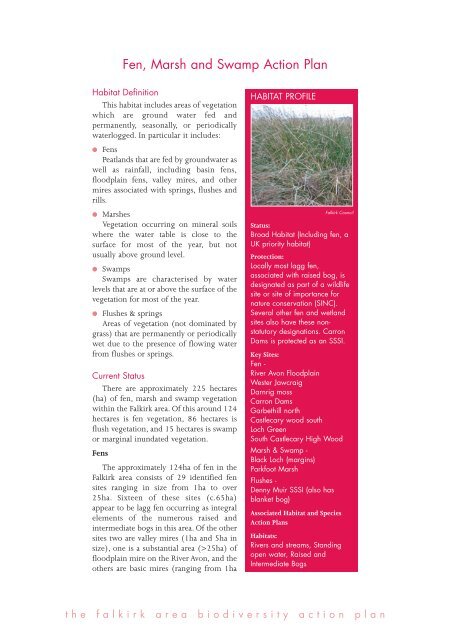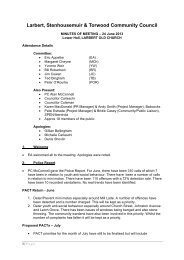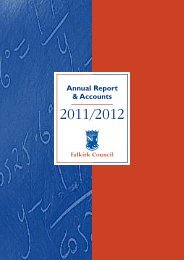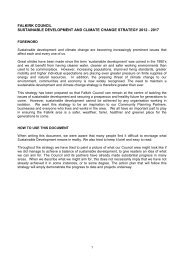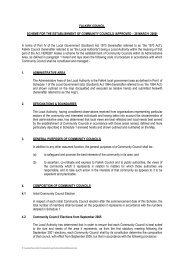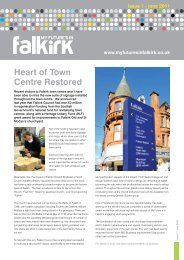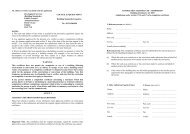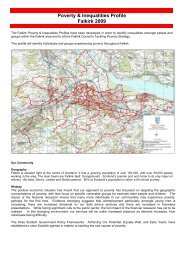Fen, Marsh & Swamp Action Plan - Falkirk Council
Fen, Marsh & Swamp Action Plan - Falkirk Council
Fen, Marsh & Swamp Action Plan - Falkirk Council
You also want an ePaper? Increase the reach of your titles
YUMPU automatically turns print PDFs into web optimized ePapers that Google loves.
<strong>Fen</strong>, <strong>Marsh</strong> and <strong>Swamp</strong> <strong>Action</strong> <strong>Plan</strong><br />
Habitat Definition<br />
This habitat includes areas of vegetation<br />
which are ground water fed and<br />
permanently, seasonally, or periodically<br />
waterlogged. In particular it includes:<br />
● <strong>Fen</strong>s<br />
Peatlands that are fed by groundwater as<br />
well as rainfall, including basin fens,<br />
floodplain fens, valley mires, and other<br />
mires associated with springs, flushes and<br />
rills.<br />
● <strong>Marsh</strong>es<br />
Vegetation occurring on mineral soils<br />
where the water table is close to the<br />
surface for most of the year, but not<br />
usually above ground level.<br />
● <strong>Swamp</strong>s<br />
<strong>Swamp</strong>s are characterised by water<br />
levels that are at or above the surface of the<br />
vegetation for most of the year.<br />
● Flushes & springs<br />
Areas of vegetation (not dominated by<br />
grass) that are permanently or periodically<br />
wet due to the presence of flowing water<br />
from flushes or springs.<br />
Current Status<br />
There are approximately 225 hectares<br />
(ha) of fen, marsh and swamp vegetation<br />
within the <strong>Falkirk</strong> area. Of this around 124<br />
hectares is fen vegetation, 86 hectares is<br />
flush vegetation, and 15 hectares is swamp<br />
or marginal inundated vegetation.<br />
<strong>Fen</strong>s<br />
The approximately 124ha of fen in the<br />
<strong>Falkirk</strong> area consists of 29 identified fen<br />
sites ranging in size from 1ha to over<br />
25ha. Sixteen of these sites (c.65ha)<br />
appear to be lagg fen occurring as integral<br />
elements of the numerous raised and<br />
intermediate bogs in this area. Of the other<br />
sites two are valley mires (1ha and 5ha in<br />
size), one is a substantial area (>25ha) of<br />
floodplain mire on the River Avon, and the<br />
others are basic mires (ranging from 1ha<br />
HABITAT PROFILE<br />
<strong>Falkirk</strong> <strong>Council</strong><br />
Status:<br />
Broad Habitat (Including fen, a<br />
UK priority habitat)<br />
Protection:<br />
Locally most lagg fen,<br />
associated with raised bog, is<br />
designated as part of a wildlife<br />
site or site of importance for<br />
nature conservation (SINC).<br />
Several other fen and wetland<br />
sites also have these nonstatutory<br />
designations. Carron<br />
Dams is protected as an SSSI.<br />
Key Sites:<br />
<strong>Fen</strong> -<br />
River Avon Floodplain<br />
Wester Jawcraig<br />
Darnrig moss<br />
Carron Dams<br />
Garbethill north<br />
Castlecary wood south<br />
Loch Green<br />
South Castlecary High Wood<br />
<strong>Marsh</strong> & <strong>Swamp</strong> -<br />
Black Loch (margins)<br />
Parkfoot <strong>Marsh</strong><br />
Flushes -<br />
Denny Muir SSSI (also has<br />
blanket bog)<br />
Associated Habitat and Species<br />
<strong>Action</strong> <strong>Plan</strong>s<br />
Habitats:<br />
Rivers and streams, Standing<br />
open water, Raised and<br />
Intermediate Bogs<br />
the falkirk area biodiversity action plan
<strong>Fen</strong>, <strong>Marsh</strong> & <strong>Swamp</strong><br />
Species:<br />
Brown long-eared bat Plecotus<br />
auritus<br />
Common frog Rana temporaria<br />
Common toad Bufo bufo<br />
Curlew Numenius arquata<br />
Freshwater Snail Lymnaea glabra<br />
Grass of Parnassus Parnassia<br />
palustris<br />
Great crested newt Triturus<br />
cristatus<br />
Hen Harrier Circus cyaneus<br />
Hoverfly Parhelophilus consimilis<br />
Otter Lutra lutra<br />
Palmate newt Triturus vulgaris<br />
Pipistrelle bat Pipistrellus<br />
pipistrellus<br />
Ragged Robin Lychnis flos-cuculi<br />
Redshank Tringa totanus<br />
Reed bunting Emberiza<br />
schoeniclus<br />
Sedge Warbler Acrocephalus<br />
schoenobaenus<br />
Short-eared owl Asio flammeus<br />
Small Pearl-bordered fritillary<br />
Boloria selene<br />
Smooth newt Triturus helveticus<br />
Snipe Gallinago gallinago<br />
Soldier-fly Beris clavipes<br />
Teal Anas crecca<br />
Water rail Rallus aquaticus<br />
Water vole Arvicola terrestris<br />
Whorled caraway Carum<br />
verticullatum<br />
Woodcock Scolopax rusticola<br />
to 6ha). Carron dams SSSI is particularly<br />
notable as the largest area of rich fen<br />
vegetation in the <strong>Falkirk</strong> area. The vast<br />
majority of these fens are found on the<br />
Slamannan Plateau to the south and west<br />
of the <strong>Falkirk</strong> area. However, several fens<br />
occur in the peaty upland fringes around<br />
Denny Muir.<br />
The area and quality trends of fens in<br />
the <strong>Falkirk</strong> area are not fully known.<br />
Within the UK as a whole the area of fen<br />
vegetation has declined dramatically over<br />
the last 100 years. It is likely that <strong>Falkirk</strong><br />
has experienced a similar decline in the<br />
area of fen and those that remain tend to<br />
be rather fragmented and isolated. It is also<br />
likely that relatively intact lagg fen is now<br />
quite scarce and this habitat is both<br />
important in its own right and a valuable<br />
element of the raised and intermediate<br />
bog habitats.<br />
<strong>Marsh</strong> and <strong>Swamp</strong><br />
Of the swamp and marginal vegetation<br />
relatively little (c.5ha) is reedbed. The<br />
remainder occurs as small areas of<br />
marginal vegetation at the edge of lochs<br />
and pools, along river and canal edges and<br />
within wet ditches and pools.<br />
It would appear that <strong>Falkirk</strong> supports at<br />
least 10 wetland sites (totalling about 5ha)<br />
which are dominated by Phragmites australis.<br />
All are less than 1ha in size and occur<br />
along drainage ditches, around the edge of<br />
small pools, along rivers and burns, or along the estuary.The condition of the<br />
identified reedbeds is unknown.<br />
Flushes<br />
The main areas of flush vegetation occur in the northwest of the area,<br />
almost all of it within the Denny<br />
Muir SSSI, in a mosaic with blanket<br />
bog and upland acid grassland.<br />
However, it is likely that many<br />
smaller areas of flush vegetation<br />
occur within habitats such as<br />
woodlands and grasslands and have<br />
not been included in these figures.<br />
the falkirk area biodiversity action plan
<strong>Fen</strong>, <strong>Marsh</strong> & <strong>Swamp</strong><br />
Within <strong>Falkirk</strong> wet vegetation communities appear to be relatively scarce<br />
and represent an important habitat of considerable conservation value. There<br />
are no clear local area and quality trends for these wetland habitats. However,<br />
wetlands generally are sensitive to natural succession to scrub, pollution and<br />
drainage and it is likely that the total area of wetland habitats has declined and<br />
that many of the remaining wetlands will have become fragmented or reduced<br />
in size.<br />
Ecology<br />
Wetland habitats can support a vast range of species, including many plants<br />
and invertebrates, which favour damp conditions, as well as numerous wetland<br />
birds and mammals such as water vole and otter.<br />
<strong>Fen</strong>s<br />
<strong>Fen</strong>s support a diverse range of plants and animals. Some can contain up to<br />
a third of all the UK’s native plant species and more than half the UK’s<br />
dragonfly species. This habitat can support several thousand insect species and<br />
is important for a range of aquatic beetles.<br />
<strong>Marsh</strong> & <strong>Swamp</strong><br />
<strong>Marsh</strong>es and swamps often represent an important transition between open<br />
water and drier habitats, and support a range of plants and animals that require<br />
the characteristic wet conditions.<br />
Reedbeds can support a distinctive breeding bird assemblage and provide<br />
roosting and feeding sites for migratory species.They also support a variety of<br />
threatened invertebrate species. Even small areas of reedbed are of considerable<br />
value.<br />
Flushes<br />
Springs and flushes are particularly important for the wide range of<br />
invertebrate species that they support, including soldier flies, crane-flies, and<br />
water beetles, as well as the flowering plants and mosses associated with them.<br />
Floodplain wetlands can also be of great value for invertebrates, particularly<br />
beetles, flies and snails.<br />
Current Factors Affecting the Habitat<br />
A range of factors contribute to the degradation or loss of these wetland<br />
habitats. These are likely to include:<br />
● Pollution from sources such as agricultural and urban runoff.<br />
● Siltation of watercourses feeding into wetlands and causing a build up of<br />
deposited silt.<br />
● Lack of appropriate management/inappropriate management of wetlands.<br />
● Succession to scrub, resulting in the habitat becoming drier.<br />
● Drainage of wetland areas, often for agricultural purposes.<br />
● Alteration to the water table as a result of development and/or drainage.<br />
● Fragmentation and isolation of wetland sites.<br />
● Afforestation.<br />
● Water extraction resulting in lowered water tables and loss of marginal<br />
vegetation.<br />
the falkirk area biodiversity action plan
<strong>Fen</strong>, <strong>Marsh</strong> & <strong>Swamp</strong><br />
Current <strong>Action</strong> and Opportunities<br />
Some surveys of open waters in the <strong>Falkirk</strong> area have also identified areas of<br />
marginal vegetation forming marsh or swamp habitats. In addition phase II<br />
surveys exist for most of this area’s lagg fen and associated raised bogs and<br />
some other key fen sites. However there is very limited survey data for most of<br />
the local fen, marsh and swamp habitat.<br />
Carron Dams SSSI, designated for its comparatively large area of rich fen<br />
vegetation, is currently managed by SWT.<br />
Agri-environment schemes offer some incentive to preserve and protect<br />
areas of wetland on farmland. In more urban areas there is potential to create<br />
new wetlands through the promotion and good design of Sustainable Urban<br />
Drainage Systems.<br />
This habitat is closely associated with raised bogs, standing open water,<br />
rivers and streams and saline lagoons, for which separate habitat action plans<br />
have been produced.<br />
the falkirk area biodiversity action plan
<strong>Fen</strong>, <strong>Marsh</strong> & <strong>Swamp</strong><br />
Objectives and Targets<br />
Objective 1<br />
Maintain the current extent of fen, marsh and swamp habitat within the<br />
<strong>Falkirk</strong> area.<br />
Target 1.1<br />
● Determine the approximate extent of different elements of this habitat<br />
within the <strong>Falkirk</strong> area and identify key fen, marsh and swamp sites. By<br />
2004.<br />
Target 1.2<br />
● Prevent loss of or serious damage to fen, marsh and swamp sites as a<br />
result of damaging development. (Ongoing).<br />
Target 1.3<br />
● Encourage the retention of fen, marsh and swamp sites by raising<br />
awareness of their value and sources of funds to maintain and manage<br />
them. By 2005 and then ongoing.<br />
Objective 2<br />
Maintain, and where possible improve, the ecological quality of existing<br />
fen, marsh and swamp habitats in the <strong>Falkirk</strong> area.<br />
Target 2.1<br />
● Promote appropriate management of fen, marsh and swamp sites.<br />
(Ongoing).<br />
Target 2.2<br />
● Identify key sites for enhancement and investigate potential<br />
enhancement projects by 2005 with a view to undertaking at least one<br />
wetland enhancement project by 2010.<br />
Objective 3<br />
Create new areas of wetland habitat.<br />
Target 3.1<br />
● Encourage creation of quality wetland areas through SUDs<br />
developments (Ongoing).<br />
Target 3.2<br />
● Promote development of new wetland areas on farmland. (Ongoing).<br />
the falkirk area biodiversity action plan
<strong>Fen</strong>, <strong>Marsh</strong> & <strong>Swamp</strong><br />
<strong>Action</strong> Potential Deliverers Year to be completed or in place Meets<br />
Lead Partners 2003 2004 2005 2006 2007 2012 objective<br />
A. Policy and Legislation<br />
1. Ensure that this habitat is afforded<br />
adequate consideration and, where<br />
possible, protected from damaging<br />
development through the planning<br />
process by:<br />
a) Developing appropriate policies<br />
within local and structure plans and<br />
other strategies as they are written and<br />
reviewed. (Ongoing).<br />
2. Ensure that this habitat is afforded<br />
adequate consideration and, where<br />
possible, protected from damaging<br />
development and enhanced through<br />
the planning process by:<br />
b) Production of supplementary<br />
planning guidance.<br />
3. Promote the inclusion of<br />
prescriptions to maintain, manage and<br />
enhance fen, marsh and swamp habitats<br />
within agri-environment schemes/<br />
policies.<br />
4. Promote the adoption of SUDs in<br />
new developments and the application<br />
of SEPA good practice to ensure they<br />
are designed to enhance biodiversity.<br />
(Also see standing open water action<br />
plan).<br />
5. Encourage the adoption and good<br />
design of SUDS (Sustainable Urban<br />
Drainage Systems) as part of<br />
developments and public schemes via<br />
the planning process. (Also see<br />
standing open water action plan).<br />
B. Site Safeguard and Management<br />
1. Ensure that any currently<br />
undesignated important fen, marsh or<br />
swamp sites are assessed and<br />
designated as Wildlife Sites or SINCs if<br />
they meet the relevant criteria.<br />
2. Encourage the inclusion of lagg fen<br />
habitat within actions to conserve<br />
associated raised bog habitat. (See<br />
raised bog action plan).<br />
3. Promote the maintenance, management<br />
and creation of fen, marsh and<br />
swamp habitats on farmland through<br />
agri-environment schemes.<br />
4. Manage Carron Dams SSSI to ensure<br />
the retention of its rich fen habitat and<br />
other marsh or swamp habitats.<br />
5. Undertake at least one fen, marsh<br />
and swamp habitat enhancement<br />
project. (From opportunities identified<br />
in D3). By 2010.<br />
Falk C WWAG ✓ ✓ ✓ ✓ ✓ ✓ 1,2,3<br />
(DS)<br />
Falk C WWAG ✓ 1,2,3<br />
(DS)<br />
SEERAD FWAG ✓ ✓ ✓ ✓ ✓ ✓ 1,2,3<br />
SAC<br />
SEPA ✓ ✓ ✓ ✓ ✓ ✓ 3<br />
Falk C SEPA ✓ ✓ ✓ ✓ ✓ ✓ 3<br />
(DS)<br />
Falk C WWAG ✓ 1,2<br />
(DS) SWT<br />
HBAG ✓ ✓ ✓ ✓ ✓ ✓ 1,2<br />
FWAG, ✓ ✓ ✓ ✓ ✓ ✓ 1,2,3<br />
SAC<br />
SWT SNH ✓ ✓ ✓ ✓ ✓ ✓ 1,2<br />
WWAG ✓ 2<br />
the falkirk area biodiversity action plan
<strong>Fen</strong>, <strong>Marsh</strong> & <strong>Swamp</strong><br />
<strong>Action</strong> Potential Deliverers Year to be completed or in place Meets<br />
C. Advisory<br />
1. Provide advice regarding the<br />
appropriate management of fen, marsh<br />
and swamp habitats and sources of<br />
funds and/or support.<br />
2. Promote good practice advice<br />
regarding the application and design of<br />
SUDS and their value for wildlife (in<br />
particular the Ponds, Pools and Lochans<br />
handbook and SUDS manual).<br />
3. Distribute copies of the LBAP and<br />
relevant action plans and any additional<br />
advisory material to owners of key fen,<br />
marsh and swamp sites (as identified in<br />
D2).<br />
D. Research and Monitoring<br />
1. Determine the approximate extent of<br />
fen, marsh and swamp habitats within<br />
the <strong>Falkirk</strong> area, and where possible<br />
their current condition.<br />
2. Identify key fen, marsh and swamp<br />
sites i.e. those that are ecologically most<br />
important.<br />
3. Identify opportunities for enhancement<br />
of fen, marsh and swamp sites,<br />
particularly at any sites identified in D2.<br />
E. Communication and Publicity<br />
1. Organise an event for landowners,<br />
land managers and other relevant<br />
groups to promote good practice in the<br />
protection, enhancement and<br />
management of fen, marsh and swamp<br />
habitats and available support and<br />
funding for such activities. (Combined<br />
with action E3 in the standing open<br />
water action plan).<br />
2. Include this habitat in the local<br />
biodiversity awareness raising and<br />
education strategy.<br />
F. <strong>Plan</strong> Monitoring and Review<br />
1. Monitor the implementation of<br />
actions in this plan annually.<br />
2. Monitor completion of actions in<br />
detail and review this plan every five<br />
years to ensure continued effectiveness,<br />
starting in 2007.<br />
Lead Partners 2003 2004 2005 2006 2007 2012 objective<br />
FWAG ✓ ✓ ✓ ✓ ✓ ✓ 1,2<br />
SAC<br />
SEPA ✓ ✓ ✓ ✓ ✓ ✓ 3<br />
WWAG ✓ 1,2,3<br />
WWAG ✓ 1,2<br />
WWAG ✓ 1,2<br />
WWAG ✓ 2<br />
WWAG FWAG, ✓ 1,2,3<br />
Falk C (DS),<br />
FABP<br />
EARAG ✓ ✓ ✓ ✓ ✓ ✓ 1,2,3<br />
WWAG All ✓ ✓ ✓ ✓ ✓ ✓ 1,2,3<br />
partners<br />
WWAG All ✓ ✓ 1,2,3<br />
partners<br />
the falkirk area biodiversity action plan
<strong>Fen</strong>, <strong>Marsh</strong> & <strong>Swamp</strong><br />
Abbreviations<br />
EARAG - Education and Awareness Raising <strong>Action</strong> Group<br />
FABP - <strong>Falkirk</strong> Area Biodiversity Partnership<br />
Falk C (DS) - <strong>Falkirk</strong> <strong>Council</strong> Development Services<br />
FWAG - Farming & Wildlife Advisory Group<br />
HBAG - Heath & Bog <strong>Action</strong> Group<br />
SAC - Scottish Agricultural College<br />
SEERAD<br />
SEPA<br />
SNH<br />
SWT<br />
WWAG<br />
- Scottish Executive Environment &<br />
Rural Affairs Department<br />
- Scottish Environment Protection Agency<br />
- Scottish Natural Heritage<br />
- Scottish Wildlife Trust<br />
- Water and Wetlands <strong>Action</strong> Group<br />
Key contacts<br />
Andy Hemingway - SEPA<br />
Scott Nisbet - FWAG<br />
Iain Fraser - SAC<br />
<strong>Plan</strong> author<br />
Anna Perks, Biodiversity Officer<br />
the falkirk area biodiversity action plan


